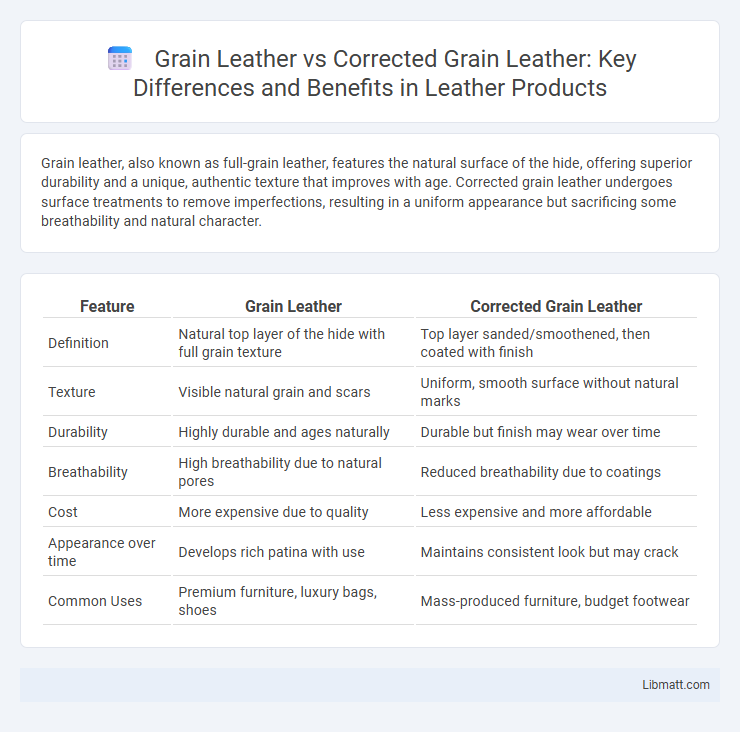Grain leather, also known as full-grain leather, features the natural surface of the hide, offering superior durability and a unique, authentic texture that improves with age. Corrected grain leather undergoes surface treatments to remove imperfections, resulting in a uniform appearance but sacrificing some breathability and natural character.
Table of Comparison
| Feature | Grain Leather | Corrected Grain Leather |
|---|---|---|
| Definition | Natural top layer of the hide with full grain texture | Top layer sanded/smoothened, then coated with finish |
| Texture | Visible natural grain and scars | Uniform, smooth surface without natural marks |
| Durability | Highly durable and ages naturally | Durable but finish may wear over time |
| Breathability | High breathability due to natural pores | Reduced breathability due to coatings |
| Cost | More expensive due to quality | Less expensive and more affordable |
| Appearance over time | Develops rich patina with use | Maintains consistent look but may crack |
| Common Uses | Premium furniture, luxury bags, shoes | Mass-produced furniture, budget footwear |
Understanding Grain Leather: Definition and Features
Grain leather refers to leather made from the top layer of the hide, retaining the natural grain pattern, which provides durability, breathability, and a rich texture. Corrected grain leather is also derived from the top layer but undergoes sanding and buffing to remove imperfections, followed by an artificial grain embossing for uniform appearance. Understanding these distinctions helps in selecting leather products based on texture preference, durability needs, and appearance consistency.
What Is Corrected Grain Leather?
Corrected grain leather is a type of leather that undergoes extensive surface treatment to mask imperfections, including sanding, buffing, and the application of synthetic coatings. This process creates a uniform appearance and enhances durability but sacrifices the natural texture and breathability found in grain leather. Unlike grain leather, which retains the hide's original surface, corrected grain leather prioritizes aesthetic consistency and resistance to wear.
Key Differences Between Grain Leather and Corrected Grain Leather
Grain leather is made from the top layer of the hide, preserving natural markings, pores, and texture, which enhances durability and unique appearance. Corrected grain leather undergoes extensive sanding and buffing to remove imperfections, followed by embossing to create a uniform texture, often sacrificing some natural characteristics for a more consistent look. The key differences lie in the preservation of natural grain, surface treatment, and overall aesthetic quality, influencing both durability and price.
Visual Appearance: Natural vs Processed Finishes
Grain leather showcases a rich, natural appearance with unique textures and patterns from the animal hide, offering genuine character and durability. Corrected grain leather undergoes sanding and embossing to mask imperfections, resulting in a more uniform but artificial finish. Your choice depends on whether you prefer authentic, varied visuals or a smooth, consistent surface in leather products.
Durability and Longevity Comparison
Grain leather offers superior durability and longevity due to its natural fiber structure, which resists wear and aging better than corrected grain leather. Corrected grain leather undergoes surface sanding and finishing, reducing its thickness and making it more prone to peeling and cracking over time. High-quality grain leather products often last decades with proper care, while corrected grain leather typically requires replacement within a few years under regular use.
Comfort and Texture: How They Feel
Grain leather offers a natural, supple texture with visible pores and imperfections that enhance breathability and comfort, making it softer and more flexible over time. Corrected grain leather undergoes surface sanding and embossing to create a uniform appearance, resulting in a thicker, less breathable material with a smoother but less natural feel. Your choice depends on whether you prefer the authentic, breathable comfort of grain leather or the consistent texture and durability of corrected grain leather.
Applications in Fashion and Upholstery
Grain leather, prized for its natural texture and durability, is widely used in high-end fashion items such as luxury handbags, jackets, and shoes, providing a premium look and long-lasting quality. Corrected grain leather, enhanced with artificial grain and protective coatings, is commonly employed in upholstery and budget-friendly fashion products, offering consistency in appearance and resistance to wear. Both materials balance aesthetic appeal and functionality, with grain leather favored for exclusive designs and corrected grain leather chosen for practical, everyday use.
Maintenance and Care Requirements
Grain leather, known for its natural surface and durability, requires minimal maintenance but benefits from regular conditioning and gentle cleaning to preserve its texture and breathability. Corrected grain leather, with its artificially embossed surface and protective coatings, is easier to clean and more resistant to stains, yet it may need less frequent conditioning due to its treated finish. Your choice impacts care routines, as grain leather demands more attentive upkeep to maintain its authentic look, while corrected grain leather offers convenience and uniformity in maintenance.
Price and Value Considerations
Grain leather, often sourced from the top layer of the hide, typically commands a higher price due to its superior durability, natural texture, and aging qualities that increase long-term value. Corrected grain leather, treated with sanding and coatings to mask imperfections, is generally more affordable but may lack the authenticity and breathability of genuine grain leather, affecting its longevity and aesthetic appeal. Consumers seeking investment pieces prioritize grain leather for its premium feel and resilience, while corrected grain leather suits budget-conscious buyers desiring a leather look without the premium price tag.
Choosing the Right Leather for Your Needs
Grain leather, including full-grain and top-grain, offers superior durability, natural texture, and breathability, making it ideal for long-lasting, high-quality products that age beautifully over time. Corrected grain leather undergoes surface sanding and coating to create a uniform finish, providing a more affordable, easily maintained option with less natural character. To choose the right leather for your needs, consider whether you prioritize authenticity and durability or a consistent appearance and budget-friendly maintenance.
Grain leather vs corrected grain leather Infographic

 libmatt.com
libmatt.com